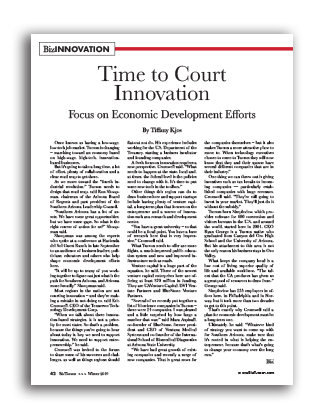
Time to Court Innovation
By Tiffany Kjos –
Focus on Economic Development Efforts
Once known as having a low-wage, low-tech job market, Tucson is changing – marching toward an economy based on high-wage, high-tech, innovation-based businesses.
But it’s going to take a long time, a lot of effort, plenty of collaboration and a clear road map to get there.
As we move toward the “fourth industrial revolution,” Tucson needs to design that road map, said Ron Shoopman, chairman of the Arizona Board of Regents and past president of the Southern Arizona Leadership Council.
“Southern Arizona has a lot of assets. We have some great opportunities, but we have some gaps. So what is the right course of action for us?” Shoopman said.
Shoopman was among the experts who spoke at a conference at Hacienda del Sol Guest Ranch in late September to an audience of business leaders, politicians, educators and others who help shape economic development efforts here.
“It will be up to many of you working together to figure out just what is the path for Southern Arizona, and Arizona more broadly,” Shoopman said.
Most regions in the nation are not courting innovation – and they’re making a mistake in not doing so, said Eric Cromwell, CEO of the Tennessee Technology Development Corp.
“When we talk about these innovation-based strategies, it is not a priority for most states. So that’s a problem, because the things you’re going to hear about today is, hey, we need to support innovation. We need to support entrepreneurship,” he said.
Cromwell was invited to the forum to share some of his successes and challenges, as well as things regions should flat-out not do. His experience includes working for the U.S. Department of the Treasury, starting a business incubator and founding companies.
A fresh focus on innovation requires a new perspective, Cromwell said. “What needs to happen at the state, local and, at times, the federal level is the policies need to change with it. It’s time to put some new tools in the toolbox.”
Other things this region can do to draw business here and support startups include having plenty of venture capital, a long-term plan that focuses on the entrepreneur and a source of innovation such as a research and development center.
“You have a great university – so that could be a focal point. You have a base of research here that is very impressive,” Cromwell said.
What Tucson needs to offer are more flights, a much-improved public education system and new and improved infrastructure such as roads.
Venture capital is a huge part of the equation, he said. Three of the newest venture capital enterprises here are offering at least $70 million in funding. They are UAVenture Capital, DVI Venture Partners and BlueStone Venture Partners.
“Several of us recently put together a list of bioscience companies in Tucson – there were 24 companies. I was pleased and a little surprised by how large a number that was,” said Mara Aspinall, co-founder of BlueStone, former president and CEO of Ventana Medical Systems and co-founder of the International School of Biomedical Diagnostics at Arizona State University.
“We have had great growth of existing companies and recently a surge of new companies. That is great news for the companies themselves – but it also makes Tucson a more attractive place to move to. When technology executives choose to come to Tucson they will now know that they and their spouse have several different companies that are in their industry.”
One thing we can throw out is giving incentives such as tax breaks to incoming companies — particularly established companies with huge revenues, Cromwell said. “They’re still going to invest in your market. They’ll just do it without the subsidy.”
Tucson-born Simpleview, which provides software for 600 convention and visitors bureaus in the U.S. and around the world, started here in 2001. CEO Ryan George is a Tucson native who graduated from Canyon del Oro High School and the University of Arizona. But his attachment to this area is not the only reason his business stays in Oro Valley.
What keeps the company local is a low cost of living, superior quality of life and available workforce. “The talent that the UA produces has given us a great pool of resources to draw from,” George said.
Simpleview has 235 employees in offices here, in Philadelphia and in Norway, but it took more than two decades to get to this point.
That’s exactly why Cromwell said a plan for economic development must be a long-term one.
Ultimately, he said, “Whatever kind of strategy you want to come up with for Southern Arizona, make sure that it’s rooted in what is helping the entrepreneur, because that’s what’s going to change your economy over the long run.”





